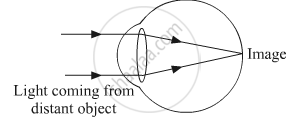Advertisements
Advertisements
Question
Explain why the image distance in the eye does not change when we change the distance of an object from the eye?
Solution
The focal length of the human lens can change i.e., increase or decrease, depending on the distance of objects and due to this the image distance in the eye does not change when we change the distance of an object from the eye. It is the ciliary muscles that modifies the curvature of the lens to change its focal length.
For example, to see a distant object clearly, the focal length of the lens should be larger. For this, the ciliary muscles relax to decrease the curvature and thereby increase the focal length of the lens. Hence, the lens becomes thin. This enables the image to be formed on the retina of the human eye.

Now if the same object is moved closer to eye, the ciliary muscles contract to increase the curvature and thereby decrease the focal length of the lens. Hence, the lens becomes thick and we still obtain the image of the object on the retina.

APPEARS IN
RELATED QUESTIONS
Explain the following:
Mechanism of generation of light-induced impulse in the retina.
The optical prescription for a pair of spectacles is :
Right eye : −3.50 D
Left eye : −4.00 D
Are these lenses thinner at the middle or at the edges?
Which of the following controls the amount of light entering the eye?
(a) ciliary muscles
(b) lens
(c) iris
(d) cornea
Which of the following changes occur when you walk out of bright sunshine into a poorly lit room?
(a) the pupil becomes larger
(b) the lens becomes thicker
(c) the ciliary muscle relaxes
(d) the pupil becomes smaller
Which part brings the image into sharp focus on the retina? How does it do this?
A person got his eyes tested. The optician's prescription for the spectacles reads:
Left eye: − 3.00 D
Right eye: − 3.50 D
The person is having a defect of vision called:
(a) presbyopia
(b) myopia
(c) astigmatism
(d) hypermetropia
Write whether the following is true or false:
Rods are the receptor cells in the retina of the eye sensitive to dimlight.
Name the following:
The part of the eye responsible for change in the size of the pupil.
Name the following:
Two pigments of the sensory cells.
Name the following:
Three layers of the eye ball.
